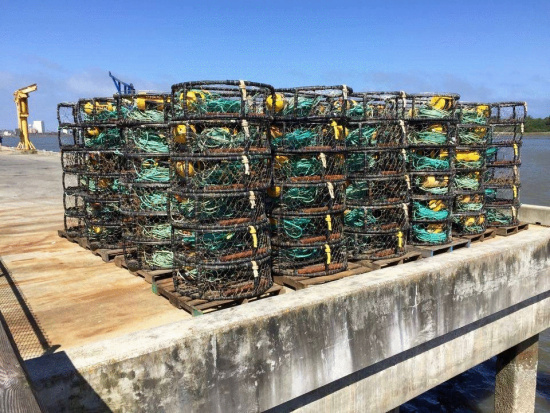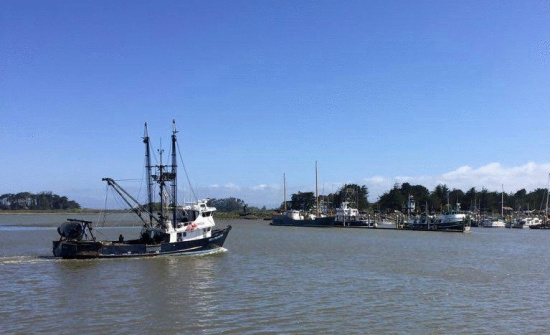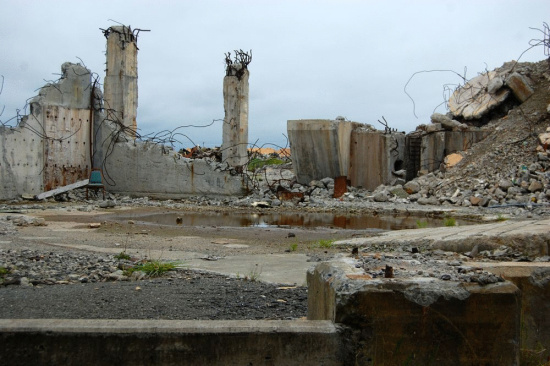Crab pots sit on the dock of Eureka’s Fisherman’s Terminal Building. | Ryan Burns
Last week, two elected officials got into a face-to-face, toe-to-toe, “let’s take this outside”-style argument during a break in a Planning Commission meeting. This wasn’t a personal beef (the men each told the Outpost afterward that they consider each other friends). Nor was it about a property dispute that affects either man directly.
No, the spat boiled over from a long-simmering political dispute over management of Humboldt Bay. Former Planning Commissioner Dennis Mayo and current Harbor Commissioner Richard Marks (the officials in last week’s quarrel) stand on separate sides of a philosophical and tactical divide that has gradually expanded to define Humboldt County’s most bitter political struggle — whether we should wait for big, blue-collar industries to arrive on our shores via sea and rail, or start allowing other businesses to use that land.
With a 5-1 vote the Planning Commission sided with the Mayo contingent, which envisions Humboldt Bay as a major industrialized seaport offering international shipping and a rebuilt (or freshly built) railroad connecting our county to the national rail network.
Marks and his fellow Harbor Commissioners, meanwhile, are pursuing a more economically diversified approach. At last week’s meeting, Division 5 Commissioner Patrick Higgins told the Planning Commission that the Harbor District almost went broke trying to market our harbor to industrial shipping interests. The time has come, he said, to loosen zoning restrictions on the vacant and deteriorating land surrounding the bay so other types of businesses can move in.
The ultimate decision on this matter lies with the Humboldt County Board of Supervisors, which will have to decide which side of that political chasm to stand on. And while their decision might not dictate the future of Humboldt Bay, it could have significant impacts on property owners and infrastructure around the harbor.
A trawler navigates the Eureka Channel toward Woodley Island Marina. | RB
This political fault line can be traced at least as far back as September 2011, when the Harbor Commission placed longtime CEO David Hull on administrative leave and then voted unanimously to terminate his contract.
The reasoning behind his termination was never made public. Regardless, it didn’t stop Hull from working on bay-related issues. In the years since he and others have embarked on a series of vaguely interconnected efforts to develop an east-west rail line from the bay to the I-5 corridor. Hull was the sole staff member of the Upstate RailConnect Committee, which sought government support and financing for a feasibility study.
The Harbor District commissioned such a study in 2013. It found that the line would cost more than $1 billion to construct and require huge volumes of cargo to sustain. Undeterred, rail boosters called for another, more extensive study. Among the numerous groups dedicated to the east-west dream are (or perhaps were?) Hull’s aforementioned Upstate RailConnect Committee, the Land Bridge Alliance, chaired by former Eureka City Manager David Tyson, and the Humboldt Bay Harbor Working Group, which positioned itself as both a vocal critic of, and a de facto alternative to, the Harbor Commission.
When the Harbor District acquired the 72-acre former pulp mill property on the Samoa Peninsula in 2013, hard-core rail enthusiasts viewed it as a misstep because it diverted resources and energy from the task at hand. That opinion remains prevalent among Harbor Commission critics, though all but a few give the District credit for overseeing the removal of nearly 3 million gallons of caustic pulping liquids from the site.
As the Harbor Commission works to transform the dilapidated industrial property into a multi-tenant business park/research center, it has bumped up against zoning restrictions that neighboring landowners have been complaining about for years.
Which brings us back to last week’s Planning Commission meeting. The Commission was considering amendments to local zoning rules that would temporarily allow a wider variety of businesses to operate on land zoned coastal-dependent industrial (CDI), provided they receive a conditional use permit. As currently written, zoning restrictions limit operations on such land (as the name suggests) to industrial operations that explicitly rely on the ocean. Historically those were lumber manufacturing and export operations.
The current zoning rules were written in the 1970s, when those industries were far more robust than they are today. In a 120-page report prepared for last week’s meeting, county staff cited a series of studies over the past 35 years, each noting the limited potential of shipping industry prospects in Humboldt Bay. The county will soon embark on updating the Humboldt Bay Area Local Coastal Plan, a lengthy and uncertain process that could officially rezone some of the county’s CDI land. But the text amendments in question now would keep CDI zoning intact while allowing other uses on a temporary basis, with permits granted for up to seven years. And CDI industries would still be given deference.
While many property owners around the bay support these loosened restrictions on CDI land, some have expressed concerns that allowing other uses on such property might choke out industrial prospects. Some also object to the idea of the Harbor District competing with private landowners for property leases, though staff noted in its report that such objections aren’t really a land use matter.
Bob Simpson is one local landowner who finds the current zoning restrictions ridiculous. He and his business partner, Charles Benbow, own a 51-acre parcel that formerly served as a chip yard for Evergreen Pulp. Eight of their 51 acres are zoned general industrial while the rest is zoned coastal-dependent industrial.
“It’s difficult to see how we can be zoned CDI when we don’t own a dock [and] we’re not adjacent to the bay or the ocean,” Simpson told the Outpost.
As industries around the bay have declined, more and more properties have been left vacant. “We have as many vacant [CDI] acres as the entire Oakland-San Francisco Bay has zoned coastal-dependent industrial,” Simpson said. This appears to be true. The Port of Oakland has roughly 900 acres zoned CDI while Humboldt Bay has 1,179 (266 of which comprise the City of Eureka airport on the west side of the Samoa Peninsula).
At last week’s meeting, County Planner Lisa Shikany noted that only 50 acres — less than 5 percent — of the bay’s total CDI land are currently used in that capacity. Historically no more than 400 acres have been used for coastal-dependent industries.
Simpson said property values have plummeted. He and his partner own 21,000 square feet of vacant office space, and his realtor has informed him that there’s a big demand for buildings in the range of 2,000 square feet to 5,000 square feet. He’d convert his office space, but none of the demand comes from ocean-related industries.
“What good is it for Humboldt County if properties like ours sit around and can’t do anything with office space?” Simpson said.
Another concern is the deteriorating infrastructure around the bay. The former pulp mill property now owned by the Harbor District is a prime example:
File photo: RB
But Shikany, the county planner, said there are plenty of other examples. Several docks around the bay need work, and pavement at a number of industrial sites has been eroding.
“When you have pavement you don’t maintain it will start to deteriorate, and the underlying conditions start creeping in,” Shikany said. Around the bay that means the native dune habitat gradually reclaims the land, which not only makes improvements more expensive and difficult; it also complicates the permitting procedure. As with the Balloon Track property in Eureka, former industrial sites in a state of disrepair can qualify under state environmental laws as wetlands, or environmentally sensitive habitat areas (ESHA).
Public speakers at the Planning Commission meeting were split, with Harbor Commissioners and several property owners speaking in favor of the amendments while some familiar Harbor Commission adversaries spoke against them.
Higgins, the 5th Division commissioner, argued that surplus CDI property could be turned into “productive, job-creating resources for this community.”
Leroy Zerlang, owner of Zerlang & Zerlang Marine Services in Fairhaven, said the eroding infrastructure around the bay is threatening to take the tax base with it. “There’s nobody more pro-shipping and barging than me … but, my friends, the horse is dead,” Zerlang said. “It’s time to change. It’s time to do something for the next generation.”
To that end, Humboldt State University Dean of Research Rita Williamson said the university supports the amendments. HSU has been in talks to open a facility in the former pulp mill property. “These areas could serve as a laboratory for projects from HSU [offering] academic programs and research initiatives,” Williamson said.
But Karen Brooks, a former candidate for Humboldt County supervisor and member of the Humboldt Bay Harbor Working Group, said, “There’s only so much of this [CDI] land to go around.” She accused the Harbor Commission of failing to market the port as a shipping venue and of holding a “philosophy against it being an industrialized harbor.”
Local attorney Bill Bertain, whose faith in Humboldt Bay’s industrial prospects is nigh unshakable, said, “I disagree with Mr. Zerlang. … We have a future with a railroad and a port.” As for zoning, Bertain said, “I think we ought to have as many acres of CDI use as we can.”
And just minutes before angrily asking Richard Marks to step outside, Dennis Mayo argued that the county went astray after David Hull’s termination and David Tyson’s retirement. “This county lost one of the best city managers and best Harbor District directors that’s ever existed,” he said.
When the commissioners themselves discussed the matter (following the 10-minute break that hosted the Marks-Mayo argument), they generally sounded wary of the proposal. District 4 Commissioner Kevin McKenny said he could see making allowances for certain properties but not loosening restrictions on all CDI properties because of the possibility of “something coming in that could be much larger than any of us could imagine.”
District 1 Commissioner Alan Bongio agreed, saying, “We just have to find the right industry to come in here.” And Commission Chair Robert Morris, the District 2 rep, echoed those sentiments. “You don’t know who’s out there in the offing maybe looking at Humboldt Bay,” he said.
District 2 Commissioner Robert Morris and at-large Commissioner Lee Ulansey both expressed skepticism that a landowner would be willing to accommodate a coastal-dependent industry after another type of tenant had moved in.
Ulansey acknowledged that the county may have a surplus of CDI property, and he suggested he might be willing to accept a compromise between the staff’s proposal and something a bit more restrictive.
District 3 Commissioner Noah Levy proved to be the only one in support of the proposal, and he noted the irony. Here was the Commission’s token liberal (himself) supporting looser restrictions on industry while his more conservative cohorts (including the leaders of the Humboldt Coalition for Property Rights, or HumCPR) were arguing to maintain restrictions on property rights.
The commission voted 5-1, with Levy dissenting and District 5 Commissioner Ben Shepherd absent, to reject the proposal.
Simpson believes the decision was based more on political allegiances than facts.
“Here’s the reality,” he said. “For whatever reason there’s a movement in the Planning Commission to try to deny everything the Harbor District wants. How is that doing the citizens of Humboldt County any good at all? It isn’t. No good whatsoever.” He said he’s not sure what the beef is ultimately about, whether it’s the Harbor Commission’s reticence over the east-west train idea or something else. “All I know is it’s a really, really foolish mistake.”
The Outpost reached out to each of the Humboldt County supervisors for their take on the issue. Second District Supervisor Estelle Fennell said that while she does have an opinion, she’d prefer not to discuss it until after the board considers the matter.
First District Supervisor Rex Bohn focused his opposition on the Harbor District, saying commissioners knew what they were getting when they acquired the old pulp mill property and now want to change zoning rules to increase their property value and compete with private businesses. Still, he suggested some CDI land could be rezoned, but all bay-front property with docks should be considered “sacred ground.”
Third District Supervisor Mark Lovelace is currently in Sacramento, and we played some phone-and-email tag, to no avail. We didn’t immediately hear back 5th District Supervisor Ryan Sundberg.
Fourth District Supervisor Virginia Bass said via email that, with her previous tenure on the Eureka City Council, she’s been attending meetings on the overabundance of CDI properties for at least 10-12 years. “I have stated in public meetings that I believe there is value in creating an opportunity for interim use,” Bass said. “There is great potential on the peninsula to create economic development and quite frankly sometimes we make it too hard.”
She stressed, however, that it’s important to ensure there’s enough property available to accommodate a variety of needs around the bay, including shipping. Bass also noted another complicating factor: approval from the California Coastal Commission.
“[T]he process to move forward with something the Coastal Commission might support was/is a monumental undertaking,” she said.



CLICK TO MANAGE